We were recently asked by The Weather Channel to share our expert tips on protecting your home during the summer season. As we enter this time of the year, rising temperatures can cause havoc on your home with increased mold, leaky air conditioners and water damage. But, there are things you can do to prevent or curtail damage to your house. Let STOP Restoration help with an FAQ breakdown for checking these maintenance tasks off your list.
Topics:
- Inspecting crawl spaces for mold and/or presence of leaking, an insulation integrity
- Leaky air conditioner pans and stopped up drains for water damage and mold growth
- Mold in residential bathrooms, and how to decide if you need professional help to remove
1. Is there a DIY list of things a regular homeowner can do to inspect their home and get ahead of these summertime problems?
Absolutely, as restoration professionals, we are thrilled to help homeowners get ahead of problems that could lead to greater damage if ignored, especially during these hot, summer months. Some of the areas you should keep an eye on include:
- Crawl spaces
- Air conditioner pan and condenser drain line
- Mold, especially inside of your home
2. What exactly is a crawl space, and what should someone be looking for?
A crawl space is an area left unfinished underneath a structure to allow access for things like plumbing, duct work, electrical wiring, etc. There’s estimated to be about 15 - 20% of homes right now with these spaces, but it’s important to mention that the preventative tips we are sharing can often apply to people’s attics and basements. So, this info is important for just about everyone.
Also important to note, is that these spaces may not be frequently viewed by homeowner to discover issues, so the summer is a great time to put on your calendar to inspect them. So, what you need to be looking for is the presence of moisture, because that’s your first indicator of any problems.
Next, we need to be looking for mold growing, which you will probably find near any leaking water. For crawl spaces and attics, you’re looking for insulation integrity - and by that, we mean checking to confirm that the insulation is in place, tucked between the joists.
3. So, you found a problem. What do you need to do about it?
First, identify how big of an issue this is.
So basically, is there mold over 10 square feet? Are there water damage materials that need to be repaired or replaced? Many times, you can DIY removing mold that is over a small space. But we at STOP Restoration typically say for larger spaces, it’s best to use professional remediation.
Next, find the source of the water.
Where is that leak coming from? We find in these spaces, many times, especially in the summer, leaking air conditioners are to blame.
4. As it gets hotter in many states, we know people are cranking up their air conditioning to stay cool. So, what are risks for damage caused by using your A/C more?

Your A/C removes heat from the air using an evaporative coil, and condensation forms. This drips into the drain pan below running out through the A/C drain line. If a clog forms in either, this can cause lots of water to leak out and cause damage, cause mold to grow. And it’s so important to catch this early, not only for the health of your A/C system, but also stopping damage before it gets worse and therefore more expensive to fix.
5. Tell us about the DIY things you can do to fix the leaking pans and stopped up drains?
This is definitely an area for our sister brand, One Hour Heating & Air Conditioning if you realize you need to call in the pros for help, but there are some things that you can do yourself to start fixing that problem, and it’s recommended to do this at least once per year to keep your drain line clear. CLICK HERE for the step-by-step list.
6. What about the water damage - like this stain on the ceiling?
So, if you have a lot of time and are somewhat handy, you could DIY this repair with the steps below, but, to make sure it’s done right, probably best to call in STOP Restoration.
- Cut out the wet dry wall
- Remove the wet insulation, dry the wood and surrounding area
- Replace insulation, replace dry wall, then paint
7. Another area to inspect is the bathrooms?
- Yes, because of water, bathroom is a common place for mold.
- Some key areas to keep an eye out for are in and around the shower, the bathtub, the sink and the toilet.
- If you spot a dark or colored area, it’s a good indicator of mold. Also, mold can grow in dark places quickly, so you may not see it.
8. How do you tell what kind of mold it is, and if it’s dangerous?

- Determining what type of mold is impossible to tell just visually.
- In the end, all mold is not good for you or your family to breathe, it affects indoor air quality. Some types of molds produce toxins and are hazardous, especially for those with compromised immune systems and allergies to it.
- So, we recommend getting rid of any mold immediately, especially because as it grows, it becomes harder and more expensive to remove.
9. What about getting rid of it? How do you know if you can DIY, or if you need a pro?
Hard Surfaces vs. Porous Surfaces:
- On hard surfaces, you can remove the mold. On porous surfaces you just have to replace, like carpet, or drywall.
- It’s so important to be safe with mold. So, it is essential to use a proper respirator, have ventilation, wear goggles and gloves.
- Use can use a water/bleach mix to treat and kill, then scrape and clean.
- But if it’s a larger area, 10 sq feet or more, or you are just uncomfortable tackling it yourself, it’s best to get professional restoration help immediately, because mold grows quickly.
10. What about insurance?
- Mold is often not covered by insurance policies.
- We don’t determine coverage, but we want to give homeowners a heads up that most insurance policies will not cover damage that they deem is part of a long-term issue that could have been addressed sooner.
- Also, if you end up having to pay out of pocket for one of these issues, it’s important to keep in mind that some contractors offer customer financing. Some STOP Restoration owners offer this to their customers.
11. How can you know if there’s mold you can’t see?
You can hire a professional hygienist to take air samples inside your home. Someone from STOP Restoration can recommend one in your area.
Need help getting the job done right? CLICK HERE to find the nearest independently owned and operated STOP Restoration near you.